Intro
First, what is time management?
According to Wikipedia
Time management is the process of planning and exercising conscious control of time spent on specific activities, especially to increase effectiveness, efficiency, and productivity.
Well, fair enough.
As long as we don’t end up like this by the end of this post, we should be fine.

Now how did I end up able to juggle a full-time job at a startup, an ongoing PhD, staying fit, keeping a social life, and staying (arguably) sane in the process?
If you are at school/university, I believe the story steps will be insightful. If you don’t feel like knowing the story behind how I got to my current approach, just jump to the end directly (no hard feelings 😒).
Mom: Where are you? When are you coming home? 🍱
For the first 2 years of university, I was working part-time giving private courses in Math and Physics for school students to be able to afford my studies.
I used to only take students who are of walking distance to my place, on the same days of the week. So my whereabouts were somehow clear.
At one point, life decided to make things a bit harder, and I needed to find a bigger source of income, which led me to taking a job as Lead Data Scientist at a startup as well as leading projects in our university research Lab. Things got way more complicated very fast and I needed a way to keep up.
Not only that, but having a random university schedule and 2 jobs made me jump around between multiple locations, and made my mom confused on what food to prepare for the day and when to expect me to be home for dinner.
Food was a main concern (I mean, it’s mom), but it is worth noting that the situation in Lebanon was bad at the time, and random explosions used to happen everywhere throughout the country. So keeping my mom up to date on my location was necessary to make her feel better. All she cared about is knowing that I am safe, and have enough food to survive the day.
To avoid answering multiple calls a day with the sole reason of knowing where I am physically, I created a simple schedule of the week showing where I am suposed to be at any point in time and hung it in the living room. The deal was: the schedule is true unless I inform you otherwise.
One day of the week looked something like this:
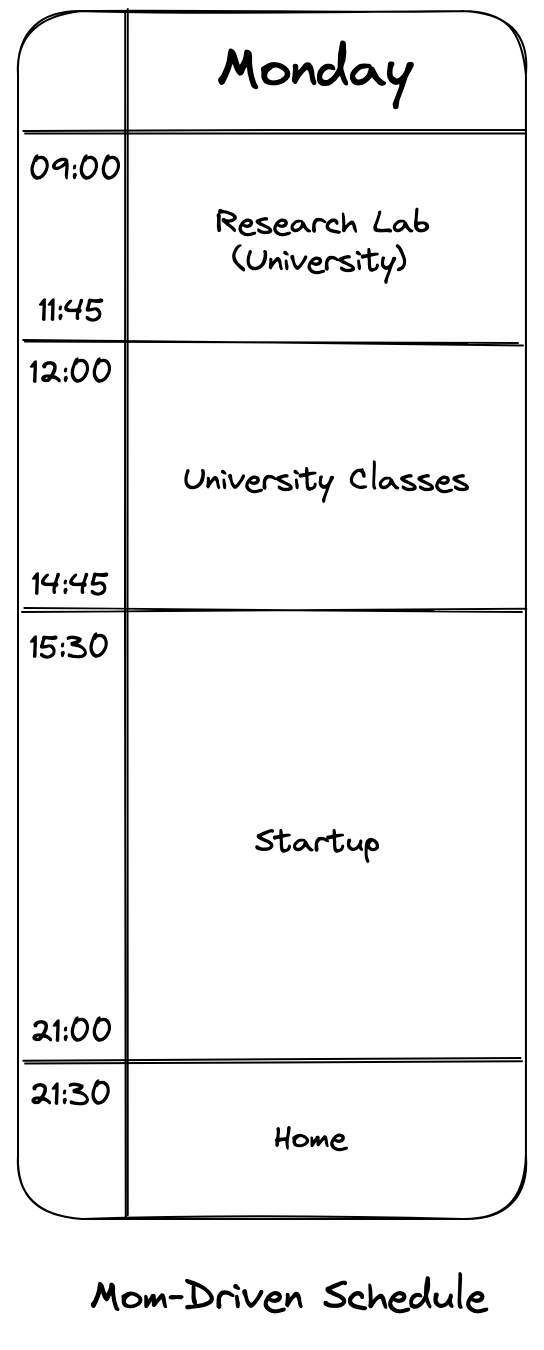
This turned out to be an amazing solution.
✅ Safety
✅ Food
Until we started talking about what I am doing at University, and how the courses are going. Mom wanted to know what is happening in general, Dad liked to go into more details on what I was learning.
The more complex the courses were, the harder it was to keep track of their names.
Dad: What is the name of this course again?… 🔭
I enjoyed our discussions a lot, and wanted us to stay in sync.
This was an easy fix here, right?
Just add the course names instead of “University”, and they will be there on the wall as a reminder.
Which looked something like this:
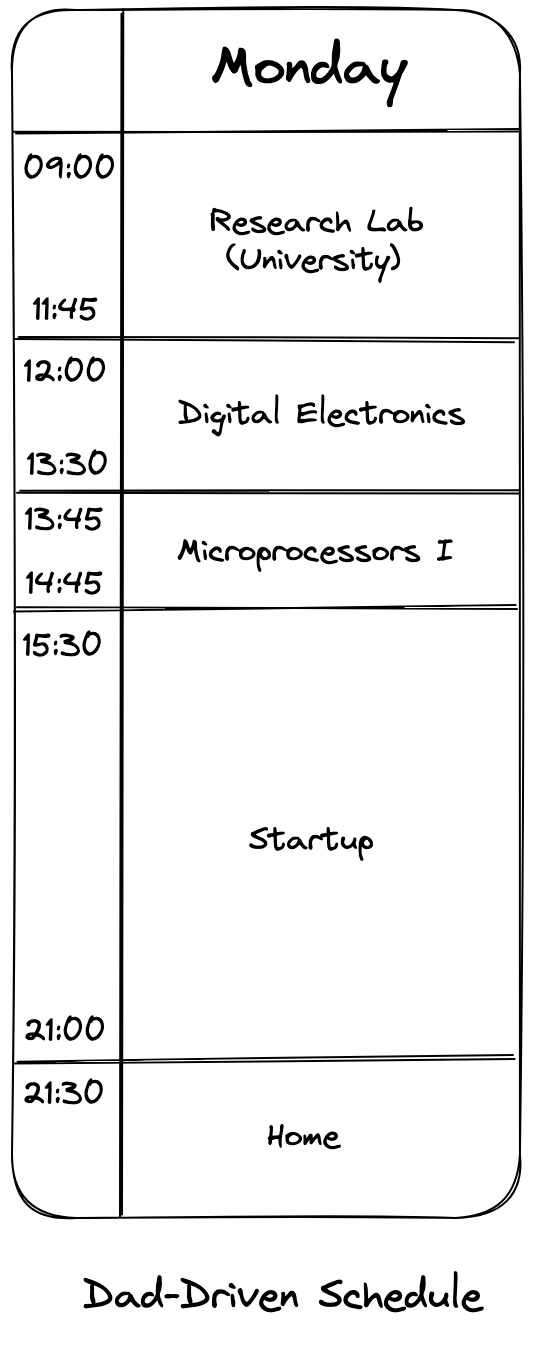
Now we have
✅ Safety
✅ Food
✅ Synced Discussions
This is nice, but…. we still didn’t solve the fact that I am working on a gazillion things at once and I need to keep my head straight.
The Enlightment 💡
As I was doing this last detailed schedule, I realized that I was more often than not checking it to know what I should be doing next, and which course to attend.
I slowly started adding the course location (building+room), and accounting more accurately for the commute times, while adding some “Relax” slots in the process.
There was also this nice side-effect of feeling less overwhelmed because I know for a fact that a some point in the day I will tackle problem X for 3 hours, so I can offload overthinking about problem X until I reach this time-slot.
Schedule Management
At this point, and maybe through some searches about time management, I landed on a blog post which was freshly posted: “The Importance of Deep Work & The 30-Hour Method for Learning a New Skill” by Azeria.
Which I not only highly recommend you to read, but would even give you a cookie if you do 🍪.
This was the first time I heard about “Deep Work”, which convinced me to try it out as I had a similar experience which randomly ended up like a time-blocking strategy.
This is when I got the Cal Newport’s Book Deep Work, and dove into it.
Reading the book, one of the main ideas was about Time-Blocking, which looked something like this:

Looks familiar, right?
I only reached such a point from personal experience, but Cal Newport was explaining scientifically why this is a great approach to plan your day and it was beautiful to read.
The main idea explained simply is
The fact of planning your day in blocks of time will help you
- Stay more focused on the current task at hand.
- Improve your effort estimation on tasks.
- Have clear expectations from yourself by end of day.
- Be more efficient overall but still adapting to different things life throws at you throughout the day.
Get the book, and block 30min a day to read it. You will thank me later.
Maximizing Efficiency
Now that I know when I am working and on what, I needed to maximize my efficiency in each one of them, namely:
- Research Lab Work
- University Courses (Class + Lab + Exams)
- Startup
All of which had 1 thing in common: Robust and Fast Learning.
Learning
To learn this skill, I decided to take the “Learning how to Learn” course offered by Barbara Oakley and Terrence Sejnowski.
The 15hours course was great, but I craved more details. So I got the book on which this course was based, “A Mind for Numbers”.
This book helped me understand how learning and memorization work (from a neuroscientist’ perspective) so I could leverage the approaches proposed in a practical way.
Simply put, here are some of the main points mentioned.
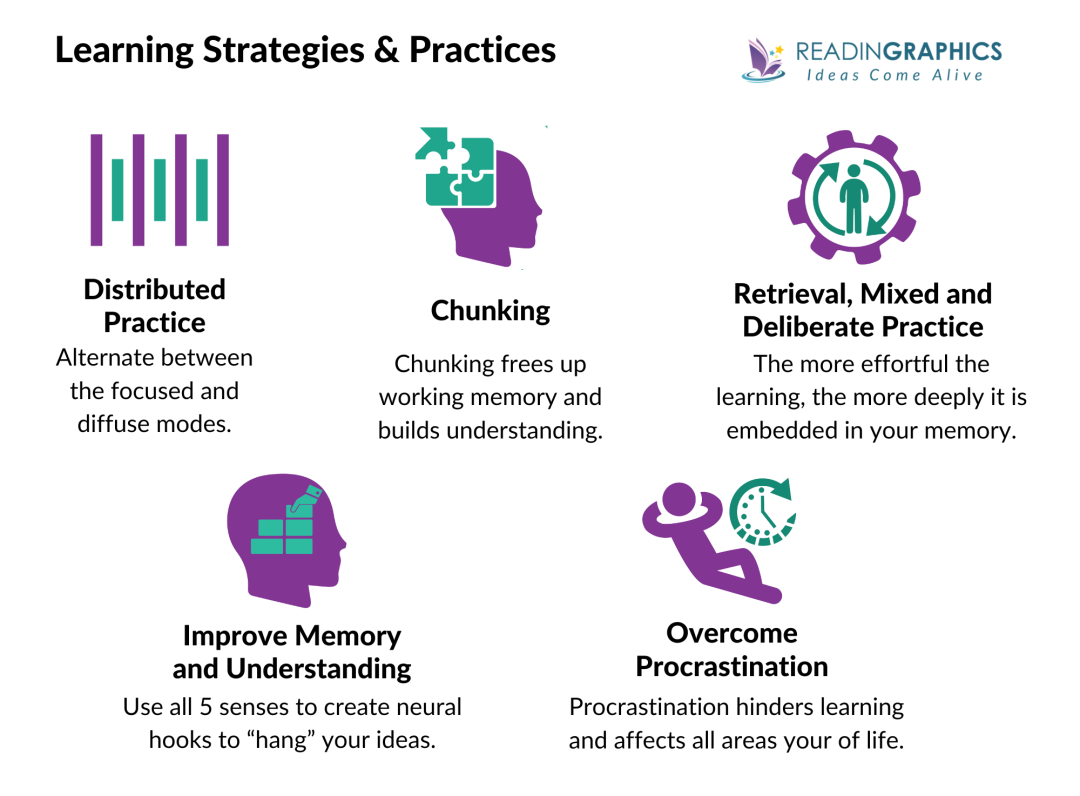
Do you know why starting with the hardest problem in your exam is actually more beneficial than starting with the easy one? You’ll find the answer in the book, and I used this trick a lot.
Note-Taking
To learn something effectively, you need to have it well represented for efficient learning. This means you need to take good notes in class. After searching for a while, I ended up with the Cornell Note Taking System.
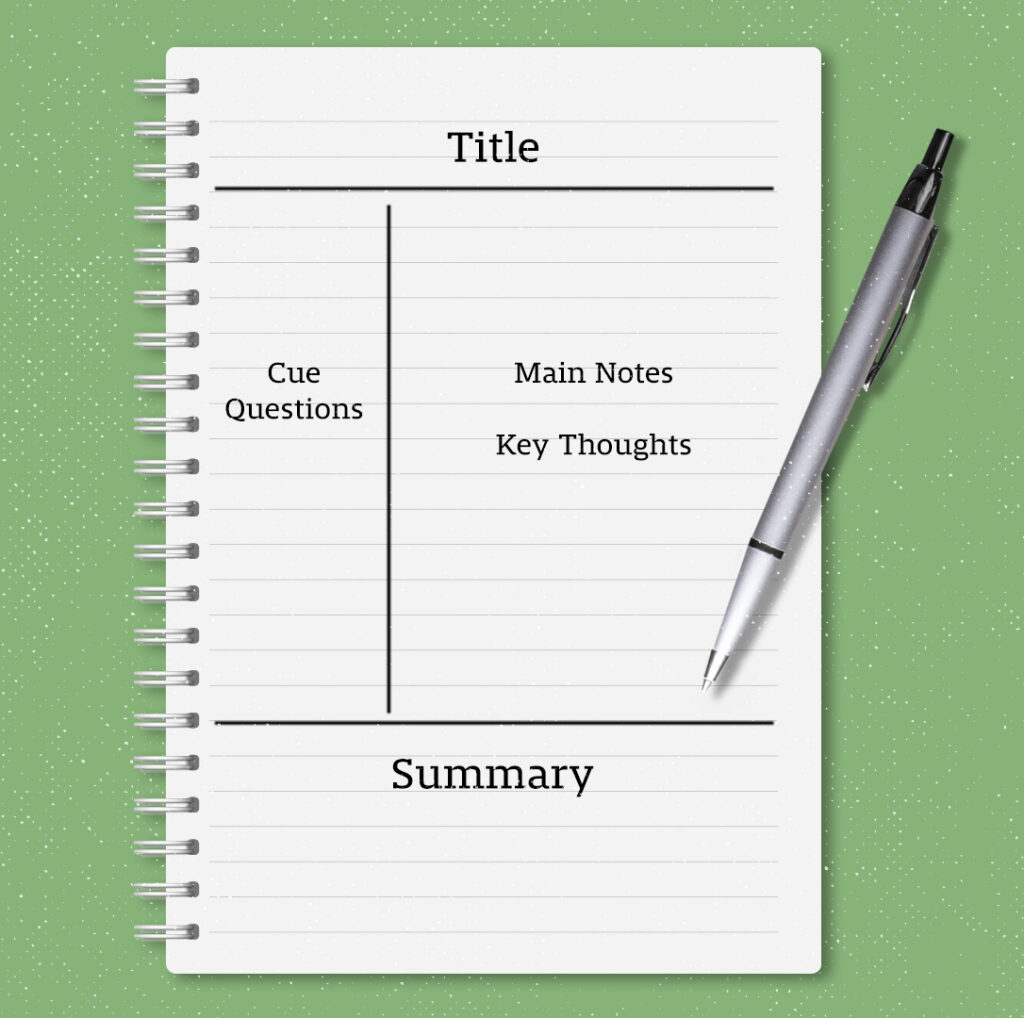
You simply split the page in 3 sections: main notes, cue questions, and summary.
- During class, you write in the main notes section.
- You then re-read it while revising and summarize the main notes in the summary section.
- While reviewing, you write down important details/questions in the **cue questions* section.
The Cornell note-taking system is based on research that shows that actively engaging with information improves retention and recall of information. By dividing information into different sections, the Cornell method enables you to process information at different levels, leading to better comprehension and memory retention. Additionally, the summary section provides a quick review of the main points, making it easier to recall information when needed.
This ended up complimenting a lot of the ideas mentioned in “A Mind for Numbers”.
My Current Approach 🐙
Fast Forward few years…
I may be taking @ProfCalNewport 's Deep Work approach too seriously 🤔
— Jean-Marc (@jeanmarcalkazzi) January 8, 2023
Been doing so since ~2018, just recently started using his Time-Block Planner.
Actually it's been amazing.
This peace of mind of knowing that "I can focus only on X now because Y is planned for later today". pic.twitter.com/Erl9bnTn9C
Now, how does it work practically?
There are multiple aspects involved, of which I will cover the following:
- Schedule Management
- Task Management
- Note-Taking
Schedule Management
The tweet is pretty clear I believe, Deep Work all the way.
The empty planner looks as follows.
Each day consists of 2 pages: one for tasks, ideas and metrics, the other for the detailed schedule.
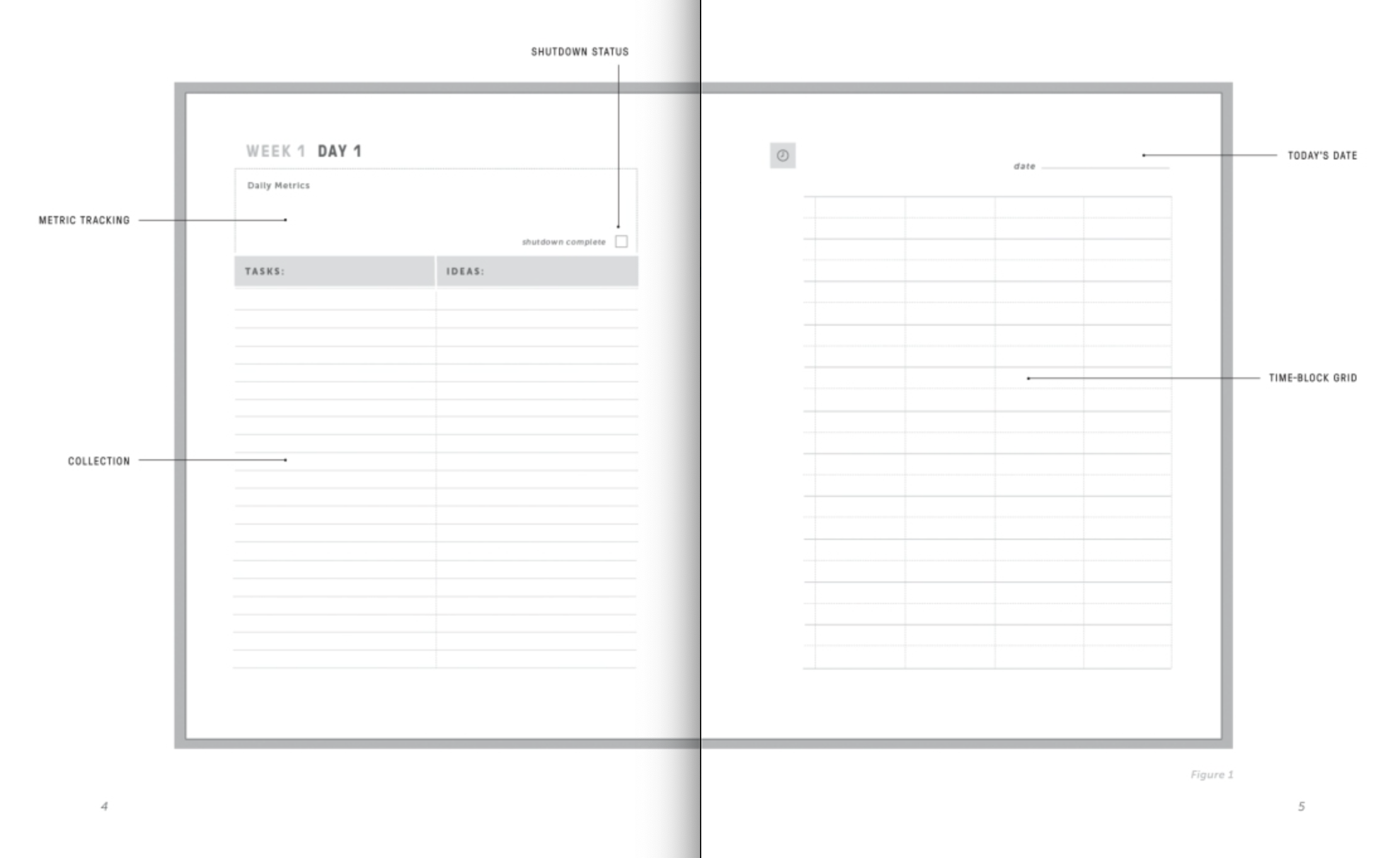
The Work Week
After experimenting for a while with such an approach, I ended up with a version that fits my own schedule, which you can see here.
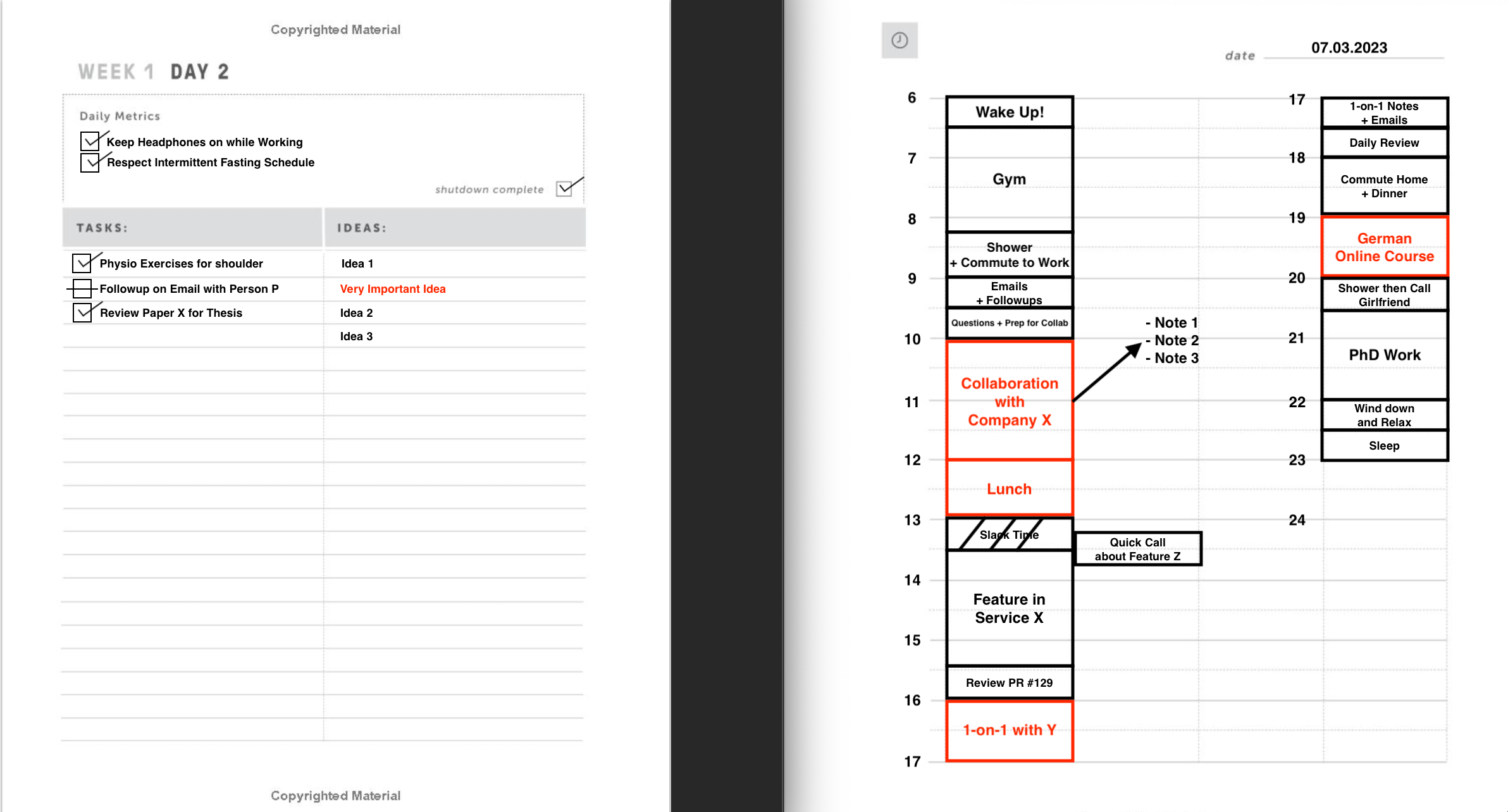
On the left side, I nearly followed the same approach mentioned in Cal Newport’s book, while color coding the “Important Ideas” in red. This helps me whenever I am doing my weekly retrospective.
On the right side, you can see my schedule crosses till night, including personal aspect (outside of my daily job) which I saw to be convenient to see in one place. Red here shows blockers I should not try to change on the same day (either involves other people in a meeting, or involves food [very important]).
All other blockers are ‘equal’ in a sense.
I try to add a “Slack Time” blocker, maybe more on other days, because regardless how well you plan, you need to adapt when faced with the real world.
This is where I cross out blocks I thought I would do, when something urgent comes up.
You can’t have a company incident you need to react to and say “well, I had something planned at this time, maybe come back tomorrow?”.
The idea of crossing out instead of erasing is very important.
Once you do the retrospective, you need to know where you miscalculated in your planning and adjust accordingly for the week after!
Try to always add in a margin for errors.
The worst that could happen is finding yourself trying to keep up with the time blocks which start leaking into the next ones and you end your day frustrated.
Priorities changed throughout the day? Adapt accordingly.
The goal of the planner is not to be written in stone, it’s about giving you visibility of what you are set out to achieve today while helping you improve your planning skills and keep track of what you are achieving.
The Weekend
So, do you do the same on a weekend?
The answer is, yes and no.
I use Saturdays as a “no screen, no work, just relax” days.
This is also a day I try to spend outside with my girlfriend, exploring new places and activities.
Sundays are “structuring, planning, learning” days.
This helps me keep up with house chores, missed tasks, and learning new things to feed my curiosity and be ready to tackle harder and harder challenges.
Take breaks as much as you need. No amount of work or success is worth sacrificing your mental health, no matter how much you try to convince yourself that it makes sense.
Task Management
Do I plan tasks only by writing them down on the planner? But what about tasks that should be done “someday” but maybe not this week? How to keep track of a plethora of things to do?
I use Things.
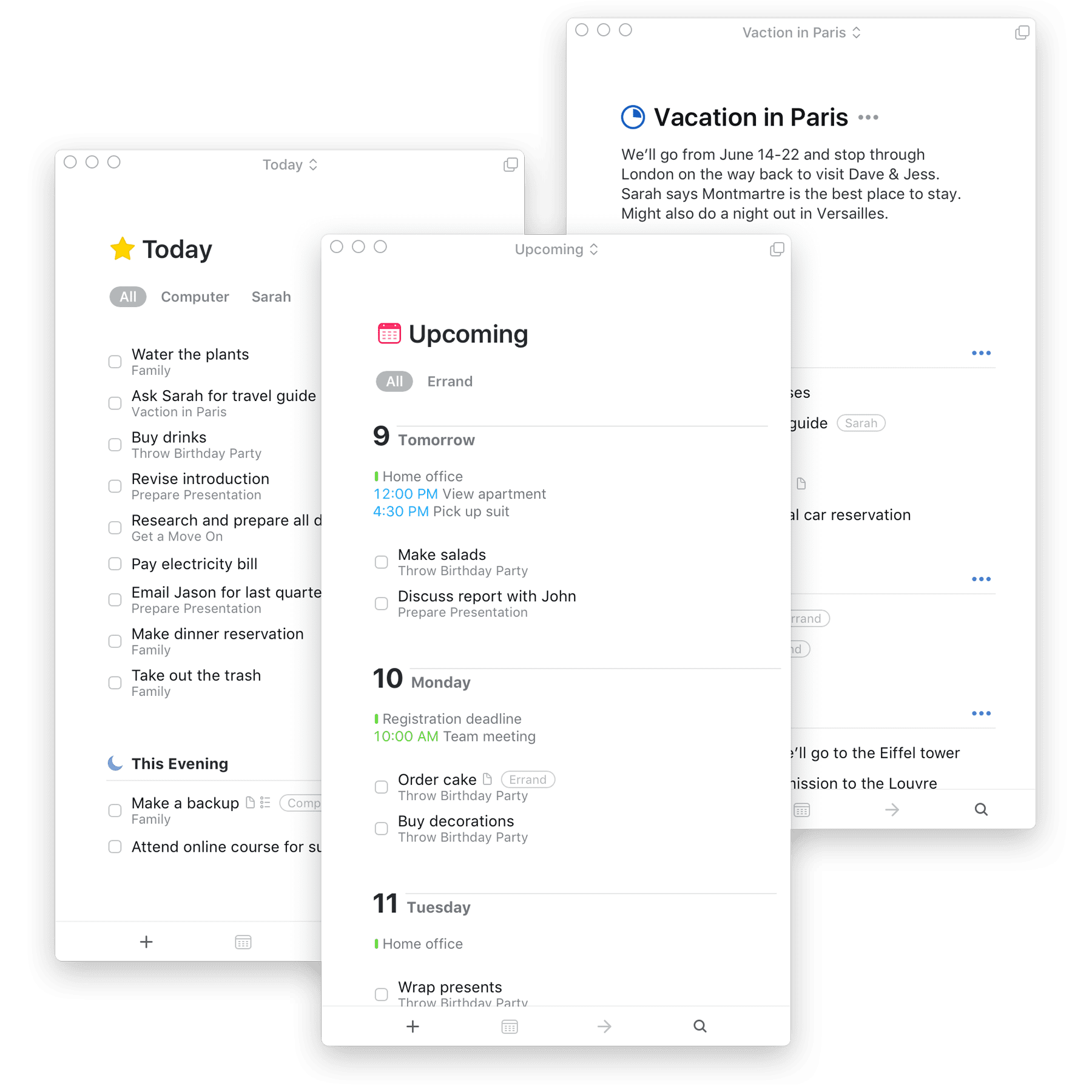
You have your:
- “Inbox”, where you add tasks before deciding when/what to do with them.
- “Today”, where you can have all tasks due today.
- “Upcoming”, where you can see future events (if calendar sync on), and tasks.
- “Anytime”, do it anytime you want?
- “Someday”, do it someday, maybe?
- “Logbook”, where you can see the history of completed tasks.
I also use what Things calls “Area” and “Project”, where I have 2 areas “Personal” and “Work”. In each I have different projects, each of which can have its own tasks. This turned out to be very similar to the PARA Method explained by Tiago Forte in his book “Building a Second Brain” which I recently read and helped me fine-tune my process (I use a similar approach for Note-Taking on Notion and for ToDos on Things3).
I like this structure for multiple reasons, but 1 in particular: I can keep track of the balance of number of tasks spread out across projects, and I can literally “see” procrastination, which triggers me to act on it.
You will see more about the steps of creating and planning ToDos in the Workflow section.
Note-Taking
Now that I am no longer taking classes at university, the Cornell Note-Taking System does not really fit my needs.
This is where I switched to a somehow custom Bullet Journal approach which I had started during University when it was just a way to track what I was doing during my work at the startup and the univeristy’s research Lab.
This is now the “Ideas” section of my planner, where it is more of a freeform section, open for thoughts and reflections.
Notes written and not retrieved are slightly better than notes never written, but not really much more useful.
That’s why I have a private GitHub repository where I copy all my notes each week, and try to augment them with some insights from having a global picture over what happened.
The interesting bit about the planner being only 13 weeks long gives you a bounded scope for covering only 1 quarter, helping you do a retrospective once done, and gives you the opportunity to “strart fresh” with the next quarter, helping you stay more and more consistent.
I also recently started using Obsidian for brainstorming with their new Canvas feature. I love global visual overview of all notes and how they relate to each other, and it turned out to be very helpful while writing my thesis now. Maybe worth another blog post for a deep dive in this one? We’ll see.
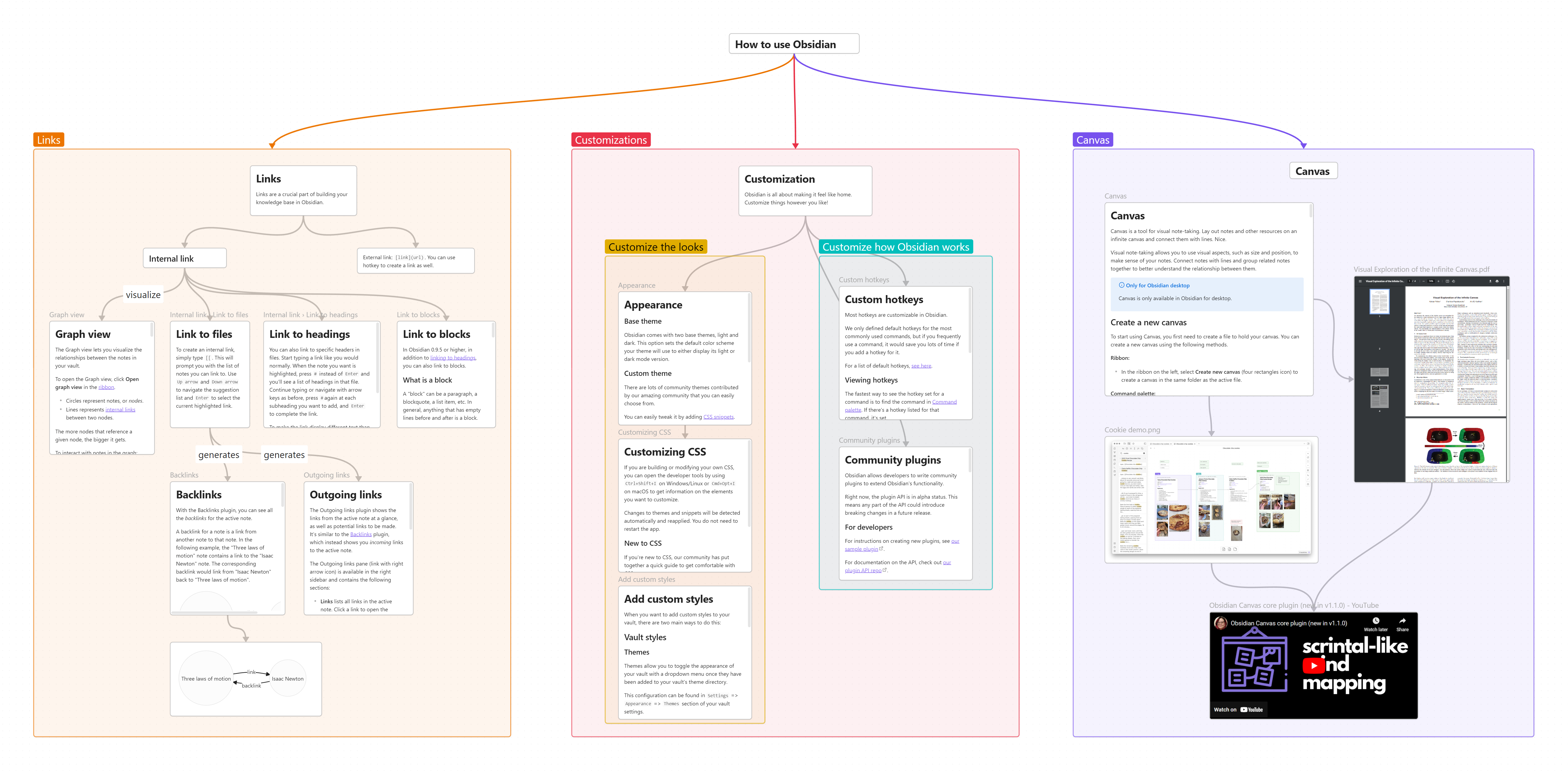
The Workflow
Whatever you read next, the most important aspect is consistency.
No amount of “10 things to boost your productivity” blogs will improve your life if you don’t stay consistent in the execution of your plan and flexible in its creation. This should have its own blog post, but for interested readers, you can check out this book.
Let’s go through a scenario to get a glimpse of the workflow.
It’s Sunday, you read this blog post, and decided to act on it.
- Write the top 3-5 big goals to achieve over the week.
- For each of the goals, split it into relevant tasks spread out through the week. You can skip to day X and write the relevant ToDos before reaching the day.
- Draw Monday’s schedule in details, based on your hobbies, work schedule, and personal events. Add relevant tasks to complete the weekly goals.
- Each day, at night, go through the tasks of the day, re-schedule what is not done, and plan the next day by drawing the schedule in details, including the tasks from your ToDo app. Copy the daily notes to your digital app of choice (in my case a GitHub repo, everything written in Markdown).
- Next Sunday, do your weekly goals’ retrospective, as well as writing notes of what you learned from the previous week.
- Repeat steps 1 to 5 for the next week, incorportating what you learned about the dynamics of your days and what works for you.
More planning usually happens at the start of each year + each quarter, as well as needed retrospectives, but they usually follow similar approaches to how weeks are planned, just on a bigger scope.
You want to improve? You need to understand your current level to realize how you can be pushed to/above your limits. This is what my workflow is about, and how I keep refining it.
Final Thoughts
Did I add every single detail? Probably missed some of which I do very intuitively now. The goal of this post is not only the resulting workflow, but the path taken to reach the final result.
The whole point of showing the path from where I was to where I ended up is to prove once more that you can figure things out. My 2 golden questions in life: How hard can it be? What could possibly go wrong? push me to take action sooner rather than later.
You don’t need to wait for the perfect timing, book, course, or mentor to teach you anything.
Just start tackling your problems with what you have now.
Whatever new insights you can learn along the way will enrich your current approach.
Is this the final best possible version of planning my life? Surely not.
Does every week look the same? Also not.
Should I feel depressed knowing that I will never reach a perfect strategy? This assumes there is a perfect strategy.
By the time you read it, I may have modified my approach. The point is to adapt and focus on improving, never reaching a stale state.
Different people will have different preferences on how to manage their time and life. There is no one-solution-fit-all approach. Take away what you need from every reference you consume and build your own personalized approach.